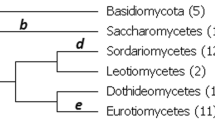Abstract.
The heat shock protein 70 kDa sequences (HSP70) are of great importance as molecular chaperones in protein folding and transport. They are abundant under conditions of cellular stress. They are highly conserved in all domains of life: Archaea, eubacteria, eukaryotes, and organelles (mitochondria, chloroplasts). A multiple alignment of a large collection of these sequences was obtained employing our symmetric-iterative ITERALIGN program (Brocchieri and Karlin 1998). Assessments of conservation are interpreted in evolutionary terms and with respect to functional implications. Many archaeal sequences (methanogens and halophiles) tend to align best with the Gram-positive sequences. These two groups also miss a signature segment [about 25 amino acids (aa) long] present in all other HSP70 species (Gupta and Golding 1993). We observed a second signature sequence of about 4 aa absent from all eukaryotic homologues, significantly aligned in all prokaryotic sequences. Consensus sequences were developed for eight groups [Archaea, Gram-positive, proteobacterial Gram-negative, singular bacteria, mitochondria, plastids, eukaryotic endoplasmic reticulum (ER) isoforms, eukaryotic cytoplasmic isoforms]. All group consensus comparisons tend to summarize better the alignments than do the individual sequence comparisons. The global individual consensus ``matches'' 87% with the consensus of consensuses sequence. A functional analysis of the global consensus identifies a (new) highly significant mixed charge cluster proximal to the carboxyl terminus of the sequence highlighting the hypercharge run EEDKKRRER (one-letter aa code used). The individual Archaea and Gram-positive sequences contain a corresponding significant mixed charge cluster in the location of the charge cluster of the consensus sequence. In contrast, the four Gram-negative proteobacterial sequences of the alignment do not have a charge cluster (even at the 5% significance level). All eukaryotic HSP70 sequences have the analogous charge cluster. Strikingly, several of the eukaryotic isoforms show multiple mixed charged clusters. These clusters were interpreted with supporting data related to HSP70 activity in facilitating chaperone, transport, and secretion function. We observed that the consensus contains only a single tryptophan residue and a single conserved cysteine. This is interpreted with respect to the target rule for disaggregating misfolded proteins. The mitochondrial HSP70 connections to bacterial HSP70 are analyzed, suggesting a polyphyletic split of Trypanosoma and Leishmania protist mitochondrial (Mt) homologues separated from Mt-animal/fungal/plant homologues. Moreover, the HSP70 sequences from the amitochondrial Entamoeba histolytica and Trichomonas vaginalis species were analyzed. The E. histolytica HSP70 is most similar to the higher eukaryotic cytoplasmic sequences, with significantly weaker alignments to ER sequences and much diminished matching to all eubacterial, mitochondrial, and chloroplast sequences. This appears to be at variance with the hypothesis that E. histolytica rather recently lost its mitochondrial organelle. T. vaginalis contains two HSP70 sequences, one Mt-like and the second similar to eukaryotic cytoplasmic sequences suggesting two diverse origins.
Similar content being viewed by others
Author information
Authors and Affiliations
Additional information
Received: 29 January 1998 / Accepted: 14 May 1998
Rights and permissions
About this article
Cite this article
Karlin, S., Brocchieri, L. Heat Shock Protein 70 Family: Multiple Sequence Comparisons, Function, and Evolution. J Mol Evol 47, 565–577 (1998). https://doi.org/10.1007/PL00006413
Issue Date:
DOI: https://doi.org/10.1007/PL00006413




